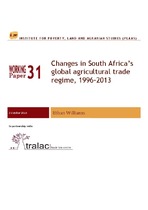| dc.contributor.author | Williams, Ethan | |
| dc.date.accessioned | 2019-03-11T12:58:11Z | |
| dc.date.available | 2019-03-11T12:58:11Z | |
| dc.date.issued | 2014-10 | |
| dc.identifier.citation | Williams E (2013) 'Changes in South Africa’s global agricultural trade regime, 1996–2013’, Working Paper 31. PLAAS, UWC: Cape Town. | en_US |
| dc.identifier.uri | http://hdl.handle.net/10566/4496 | |
| dc.description.abstract | This paper presents an examination of the major trends in South African international trade in
agricultural products between the years 1996 and 2013. The analysis covers three broad areas: (1)
the changing weight of key trading partners in South Africa’s overall agricultural trade regime; (2)
changes in the major products being traded with the rest of the world; and (3) changes in the
products being traded with each of its key trading partners. The paper begins by analysing the
changes in the total export and total import values to and from the trading partners identified
above, and the changing shares of total value held by each partner. The next section focuses on the
major products traded in terms of value – both how the composition of the product profile has
transformed, and the main sources of the trade in these products. Finally, each trading partner is
given individual focus. The EU remained the dominant source of imports and the dominant
destination for exports throughout the period. The import market shifted dramatically away from
the US and Africa toward Brazil and China. In the export market, the presence of the USA, Japan and
MERCUSOR receded whilst Africa and China underwent strong growth. The top two export
destinations, the EU and Africa, dominated the market by a significant margin, accounting for well
over half of total export value throughout. Rice and wheat were the dominant products within the
import market throughout the period, whilst the position of poultry meat strengthened and
sunflower-seed oil receded. In poultry meat imports, the USA saw sharp decline, whilst South
America and the EU underwent a very strong rise. The major shifts in the export market were away
from sugar and titanium oxide, and towards fresh fruit and wine. | en_US |
| dc.language.iso | en | en_US |
| dc.publisher | Institute for Poverty, Land and Agrarian Studies, University of the Western Cape | en_US |
| dc.relation.ispartofseries | Working Paper;31 | |
| dc.subject | Agriculture | en_US |
| dc.subject | International trade | en_US |
| dc.subject | Global partners | en_US |
| dc.subject | Exports | en_US |
| dc.subject | Imports | en_US |
| dc.title | Changes in South Africa’s global agricultural trade regime, 1996–2013 | en_US |
| dc.type | Working Paper | en_US |

